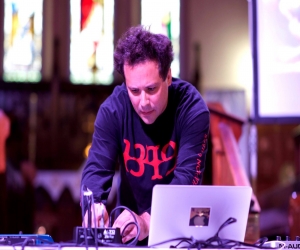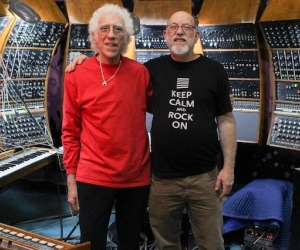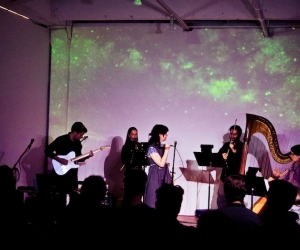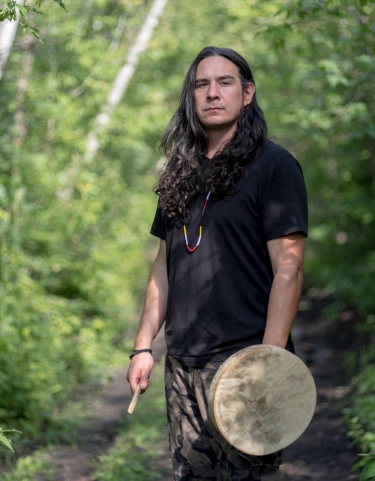
In early July 2020 it was my pleasure to interview Tlicho Dene interdisciplinary artist Casey Koyczan. He is extremely generous and open. I have done my best to represent our conversation in order for readers to discover and understand his creative practices.
Focusing on the Northwest Territories, specifically Yellowknife, where he lived for several years, Koyczan explores Indigenous futurity (see end note), and primarily Tlicho futurity, through his music, visual art, and interdisciplinary work. One question he asks himself is: How will Dene (the larger designation that comprises the Tlicho people) drummers play and sing together in drum circles a hundred years in the future? Koyczan explores these questions by creating his own futures, using varied media, including, but not limited to, virtual reality, MIDI-triggered visuals, scents, sounds, beading, installation, and performance.
[Interview sections have been condensed and edited by the author and the Musicworks editor.]
a fresh start
From February 2019 to February 2020, Koyczan took a break from making music to focus on visual art, residencies, exhibits, projects, and artist talks. He moved to Winnipeg in 2019 to begin his first year as a graduate student in the Master of Fine Arts program at the University of Manitoba (UofM) and soon found that he could restart the balancing act between his art and music practices. Koyczan also frequently gets requests to work on soundtracks and scores. This break has allowed him to return to music with fresh ears, now that he has a different home-studio set up for his gear and software.
In light of COVID-19, the future is a bigger question mark than ever: we are paused, Koyczan says, and now we’re waiting—with little ability to predict when “play” will be pressed again. Koyczan’s weekly grad seminar was cancelled because of COVID-19, and rightly so, he says. Adapting to this new situation, he has been creating in his home studio artwork that is more involved with audio, video, and MIDI-triggering. When the stay-at-home orders came down, Koyczan had already prepared himself for the closures and loss of access to his UofM studio space by setting up a workbench and foldable tables. He described to me his setup for working from home.
Casey Koyczan: I set up a little construction area in my porch. I developed my home studio a lot more, so I have four workstations now. One is mainly for audio—where I do all my jamming and my composition work. Another desk with a dual-monitor setup and my mixing speakers is where I do all my digital work, like VR. Another station is geared more towards working with traditional materials, beadwork, and gadgetry-related things. The porch is where I use my Dremel tool, sawing and soldering, and all that sort of stuff. So, I’m set up!
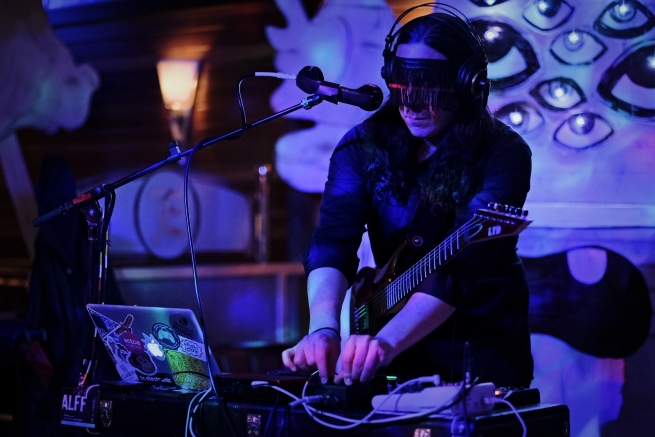
NÀHGĄ journey
Before NÀHGĄ became the stage name for Koyczan’s interdisciplinary music practice, which evolved from his original style of a live-looping solo performance, he moved through two other names, one that he felt was too corny, and then simply The Bushman, which proved to be confusing, as several other artists also went by this name or ones similar to it.
Mercedes Webb: I’m interested in the bushman aspect of NÀHGĄ, because there are many varieties of bushmen in Indigenous stories, like Gaagiixid (“the Wildman”) in the Haida film Sg̱aawaay Ḵ’uuna (Edge of the Knife). What does the bushman story look like for NÀHGĄ?
CK: Nàhgą is the Tlicho word for bushman. There are different interpretations of what bushman is within our culture and within regional cultures, but the way I and other people understand Nàhgą is the spirit of the woods: Nàhgą can have both good and bad connotations. The way I see it is as the protector of the woods: it’s there to ensure that people are respecting the land, water, animals, and inhabitants of the land. There’s a reminder and a warning because bushman is known to mess with your head in the woods, and confuse you in terms of direction and make it so you can’t find your way back home.
That’s my interpretation of it. I think of it as a spirit to be respected, and a reminder to respect the earth. Other people interpret Nàhgą as actual wild people who were born in the woods and live in the woods and have an abundance of hair on their body and are primal. That’s not the way I interpret it, but I respect other people’s interpretations.
MW: Your 2013 multimedia installation Emotive Ascension [which, on his website, Koyczan describes as “a representation of nature reclaiming an architectural space”] focuses on what we should be respecting and, maybe less obviously, what we should be resisting. Do you feel that this respect for that being [Nàhgą] comes through in a lot of your work?
CK: In my music, definitely. More of my electronic work that’s heavier can have dark elements with mysticism appended to it. With the live looping atmospheric stuff, I find I can really lean in to more of a euphoric, hip-hop sense that amalgamates all these different styles. When I play as NÀHGĄ, I dress to fit the role in a loose interpretation of what Nàhgą is—so, all in black, dress shoes, dress shirt: that’s more of a formal element.
I wear a beaded eye cover; it’s found throughout various forms of Indigenous culture. Basically, what that does is cover my eyes, so you can’t see them, but I can see everything—it’s kind of like wearing a hockey cage on your helmet and after a while you almost forget that it’s there. The beaded eye-cover design is all black with dyed-black muskox leather and a single strand of red beads that goes throughout the middle of the eye cover. The red strand is to reflect my inspiration by not only Nàhgą but sci-fi culture, because in a lot of sci-fi movies the villains or evil robots have red eyes or a red scan-line.
It’s also to pay tribute to our artists up there [the Northwest Territories] who deserve that recognition. I have two eye covers now that I commissioned from Gerri Sharpe, an artist from the Northwest Territories. It also helps with anxiety and stage fright, because they can’t see my eyes, but I can see everything.
MW: On your Bandcamp page, I notice that you have quite a few collaborations. What role does collaboration play in your practice?
CK: Collaborations are really important, especially for a solo artist, because they help you gain a better understanding of your own work. Someone else coming in with their own style helps you to adapt, but also to grow. I found that sometimes when I was collaborating with people, it pushed me to do better and be even more experimental. They’ve been very good experiences, and I’m very glad that those collaborations happened.
My EP Yíídiikò, which stands for electricity in Tlicho, was an experiment with electricity, and a reflection on moving my production to Ableton from ProTools. When I switched over to Ableton, everything clicked; I like to say that Ableton understands me as opposed to me being able to understand Ableton. Ableton also has a heavy art aspect, because you can communicate with a variety of programs receiving MIDI notes and triggers. Especially with its Max For Live platform, which allows you to synch up and interact with MXP [visual programming language for music and multimedia] inside Ableton. It opens infinite doors on what you can do, not only in music but in visual art. Ableton is one of my biggest influences in regard to collaboration, because I can work with programmers or visual artists more easily. Some songs from Yíídiikò will be on my next album, but because all of them are instrumental I’d like to collaborate with some lyricists, rappers, singers; so I’m going to see who’s interested—in Winnipeg, nationally, and internationally.
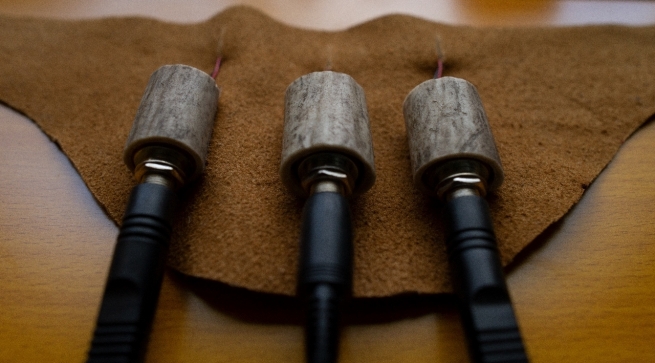
into futurities
Koyczan’s installation Emotive Ascension (2013, BFA Grad Exhibition, Thompson Rivers University, Kamloops, B.C.) is inspired by the scene in Ridley Scott’s 1979 sci-fi film Alien in which the Xenomorph Queen is giving birth to numerous eggs. In Emotive Ascension, trees are reclaiming their space through physical presence, olfactory engagement, and audio. Koyczan is working on a second, much larger iteration of this piece.
Instead of one tree, there are going to be seven big logs that will have an interactive component utilizing 360º laser-range scanners that will be imbedded in them and hooked up to Raspberry Pi’s (microcomputers) that can sense people’s proximity to the logs, adjust volume accordingly, and trigger sounds—for example, a Dene drum. When triggered by multiple people in the space, together the logs will create one song. The forthcoming (2021) second iteration of Emotive Ascension, which will be called Nàèdi; Medicine will have a performance component called “The Balance,” which Koyczan describes in his answer to the following question.
MW: I’m going to jump to methods of resistance expressed in your art and music. Although it’s not always readily readable by certain folks, I find that there is in your futurity works an exploration of reclaiming space. Emotive Ascension includes the sound of Earth and a tree in the middle of the space—it’s a futurity you’re making where the visitor can be in the space and experience a possible future. I see Indigenous futurities as intrinsically linked with resistance, but wonder how your exploration of Indigenous futurity—through your undergraduate work in Kamloops and now your graduate work in Winnipeg—has impacted how far your mind can go.
CK: “The Balance” relates heavily to my Dene drum, because our drums in Dene culture and the Northwest Territories have two strips of hide stretching along the face, which add to the vibrations of the songs and improve the drum’s connection to water and spirits. It’s also symbolic and influences the concept of “The Balance.” Those two strips are there to represent the balance of life and death, good and evil, land and sky, and everything in between. My Dene drum will have a contact mike picking up that vibration and resonance. I’m also creating a choker out of moose hide; I am learning to bead so it will be beaded in my own style, which I’m intending to look simple. But beading is a challenge, and I’m lucky to have friends here that have the patience to teach me.
In addition to the beading, I’ve hollowed out three cylinders of caribou antler [see photo above] and imbedded quarter-inch jacks in them, which are connected to three contact mikes that will be on my throat. I have a bass-heavy voice so the middle mike will be the bass, the left will be mids, and the right will be treble. The four signals from my drum and choker will go into my interface. Everything will be deciphered, and then those signals will be sent to Ableton to trigger audio samples, and to a visual program to trigger video samples. For instance, if I hit my drum in a four-four pattern, the first three times that I hit my drum it’ll be a kick-bass sound, and on the fourth hit it’ll be the sound of lightning. That will correspond to the visuals with, for example, three plumes of smoke, then the fourth hit will be a visual of lightning. At the same time, the chanting that I’ll be doing in correlation with the choker will trigger more harmonious aspects that will be heavily delayed with some reverb and distortion that will visually trigger wind and snow to create a balance with the harsh impact of the drum and the harmonious aspects of the chanting.
One of the inspirations behind this project itself is the question, how are our Dene drummers going to play and sing together in drum circles a hundred years in the future? Everyone could have these chokers and a dome of visuals and holograms—this is where my mind goes. The project is still in its infancy and will take a lot of programming to get working, but that is one of my thesis projects for school and hopefully I will be presenting that in April of 2021 alongside my installation.
Audio: Standing On Ice (2019) Composed and performed by Marina Hasselberg (cello) and Casey Koyczan (beats, arranging, production, mastering). Previously unreleased.
Top photo of Casey Koyczan by Robert Szkolnicki. Middle photo of NÀHGĄ (Casey Koyczan) by Devon Lindsay. Bottom photo, of caribou antler with jacks embedded, by Casey Koyczan.
